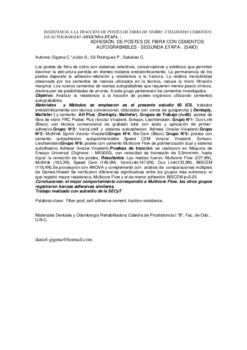| dc.description.abstract | FIBER POST ADHESION WITH SELF-ADHESIVE CEMENTS - SECOND PHASE- The glass fiber post are retentive system to see the lost structure in endodontic treated teeth. The permanence of posts depends the adhesion-retention and resistance to the fracture. The relative insolubilidad observed by resin cements used in the technique, reduces micro marginal filtration. The new autograbables resin cements that require less clinical steps, diminish the possibilities of errors. To this group the investigated cements belong. Objective: To analyze the tensile strenght of organic posts being used autograbables cements. Materials and Methods: were used in the present study 60 ICS, deal endodónticamente with conventional technique, obturated with gutta-percha cones (Dentsply, Maillefer) and cement AH Plus (Dentsply, Maillefer). Work groups (n=60) posts of fiber glass FRC Postec Plus (Ivoclar Vivadent. Schaan, Liechtenstein. Group N°1: Duo-Link (Bisco) with conventional technique of total engraving with acid and application of first-sticky. Group N°2: VarioLinkII and self-adhesive system Adhese (Ivoclar-Vivadent). Group N°3: Multilink Sprint (Ivoclar-Vivadent) Group N°4: Bis-Cem (Bisco) Group N°5: posts with self-adhesive cement autopolimerizable Speed CEM (Ivoclar Vivadent. Schaan, Liechtenstein) Group N°6: posts with cement Multicore Flow of dual curing and autodhesivo system Adhese (Ivoclar-Vivadent). Tests of traction: they were made in Machine of Universal Test (Diginess - MX5000), with speed of crosspiece of 0,5mm/min, until obtaining the removal of posts. Results: the averages were: Multicore Flow (227,6N), Multilink (163,3N), Speed Cem (149,0N), VarioLink (147,6N), Pair Link (133,8N), BISCEM (116,4N). They were processed with ANOVA and complemented with analysis of multiple comparisons of Games-Howell verified significant differences between the most extreme groups: the one that registered greater resistance, Multicore Flow and the one of smaller adhesion: BISCEM p< 0.05. Conclusions: the best behavior corresponded to Multicore Flow, the other groups registered similar sticky forces. Work made with subsidy of the SECyT | en |





